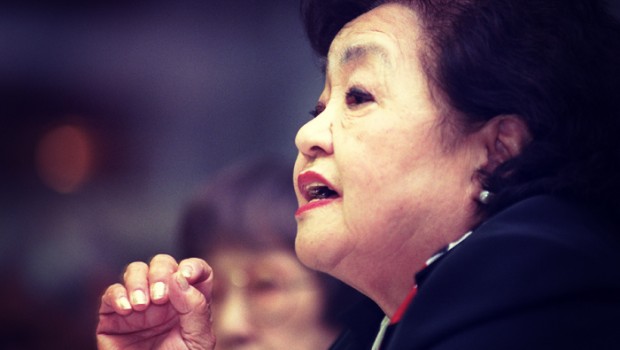By ICAN*
“I turned around and saw the outside world. Although it was morning, it looked like twilight because of the dust and smoke in the air. People at a distance saw the mushroom cloud and heard a thunderous roar. But I did not see the cloud because I was in it. I did not hear the roar, just the deadly silence broken only by the groans of the injured.
Streams of stunned people were slowly shuffling from the city centre toward nearby hills. They were naked or tattered, burned, blackened and swollen.
Eyes were swollen shut and some had eyeballs hanging out of their sockets.
They were bleeding, ghostly figures like a slow-motion image from an old silent movie. Many held their hands above the level of their hearts to lessen the throbbing pain of their burns.
Strips of skin and flesh hung like ribbons from their bones.
Often these ghostly figures would collapse in heaps never to rise again.
With a few surviving classmates I joined the procession carefully stepping over the dead and dying.”
Setsuko Thurlow was 13 years old when the nuclear bomb dubbed “Little Boy” was dropped from a B-29 bomber, the ‘Enola Gay’, and detonated over her home city of Hiroshima at 8:15am on 6 August 1945.
That morning she was reporting for her first day of work at the army headquarters, part of a group of 30 who had been assigned there.
Her memory of the explosion was a “bluish-white flash like a magnesium flare” outside the window, immediately followed by the explosion whose force leveled the building she was in, rendering her temporarily unconscious and covering her with smoldering rubble.
She was pulled free from the ruins of the building only moments before they caught fire – with many of her classmates still unable to get out.
As she looked out upon the city for the first time after the explosion, she saw a landscape that was utterly devastated.
But worse was the sight of the thousands upon thousands of dead, dying and maimed – the “ghostly figures”.
Thurlow’s sister and her 4-year old son had been outside at the time of the explosion and suffered burns to such an extent that they were unrecognizable to their own family.
They died a few days later – having received no medical care – and their bodies were thrown into a pit by soldiers, doused with gasoline and set alight. Her uncle and aunt showed no visible injuries from the explosion itself, but suffered radiation poisoning a couple weeks afterwards, with purple lesions, bouts of nausea and hair loss among the symptoms.
Thurlow says that it is the image of her dying nephew, Ejii, “representing the innocent children of the world, [which] compels and drives [her] to continue to speak of Hiroshima, no matter how painful it may be,” on behalf of all who have suffered from the development, testing and use of nuclear weapons.
On October 26, 2011 she delivered a speech at the First Committee of the United Nations General Assembly.
She did not hold back from telling the truth about the consequences of the nuclear detonation that she had seen that day.
Her experiences and those of other Hibakusha compelled them to do what they could to make sure that no human being would go through what they did. They made it their mission to make their voices heard about the horror of nuclear weapons.
We believe that humanity and nuclear weapons cannot coexist, and for the past several decades we have been speaking out around the world for the total abolition of nuclear weapons, as the only path to security and the preservation of the human community and civilisation for future generations. But has the world heard our plea? Has it listened to the cries of billions from around the world who desire peace not war, life not death?
September 20, 2013










